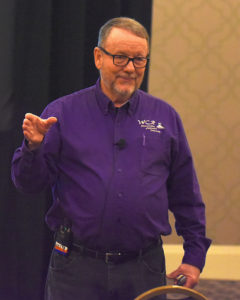Daily Dicamba Update: Dicamba Revised: Is It Enough?
Larry Steckel is convinced 2018 is going to be a better year for dicamba, at least in his home state of Tennessee.
“In our (dicamba) trainings, we put a good amount of fear in it, and I think it took hold,” the Professor of Row Crop Weed Management at the University of Tennessee says, only half-joking.

Larry Steckel
In the online training module in which he took part as a county extension agent, “I came right out at the front and took everybody to task and told them that the stakes could not be higher. If we lose this technology, we’re going to struggle to get anything new labeled, and it’s really going to be a shame to lose it from that end, but also to lose it from a resistance management standpoint. Liberty is the only other option we’ve got in soybeans right now, and we’ve put a lot of selection pressure on it for Palmer amaranth over the last five to six years, and if we lose it to resistance, we’ve lost a heck of a tool, and we could see resistance blow up even quicker,” he explains. “I think people took it more to heart and were more serious about it.”
To be sure, fewer acres will be in harm’s way. Around 80% of Tennessee’s soybean fields will be Xtend this year, while Xtend is set to comprise around 40% of all U.S. soy fields — double last year’s total, according to Monsanto’s estimates. All in all, about three times as much dicamba will be sprayed this year over last year, and about six times more dicamba will be sprayed than has ever been sprayed in a calendar year.
If 2018 marks the final year for dicamba, it won’t be for lack of effort. Stricter rules are in place, thousands more hours of mandatory training are in the books, and there are new tools aplenty to help applicators make on-target applications.

Bill Johnson
Changes to the label should reduce drift problems this season, but ultimately weather patterns will be the major driver, according to Bill Johnson, Professor of Botany and Plant Pathology at Purdue University.
“If we get backed into a corner with long, extended wet spells, and we’re not able to spray, and then as soon as we’re able to spray we have windy conditions, inversions, or warm temperatures that increase volatility, we could end up having a repeat of last year,” he says. In Johnson’s view, a repeat scenario is more likely than not.
Johnson echoes what many others have said, and it’s partly why the dicamba debate is so emotionally charged: “It’s impossible to be 100% in compliance.” The label is so restrictive that any next steps will have to be on improving the formulation, he says.
From the third week of June through Labor Day last year, Johnson fielded many daily calls from growers dealing with drift damage. Impacts on yields were not as great as people had feared. “But we still have to remember that it’s chemical trespass,” he says. “If the stuff moves off-site or injures somebody else, there’s a problem.”
Chad Asmus, BASF Technical Marketing Manager, maintains that understanding and following label guidelines has always been critical for maintaining on-target applications.
“Even not following one of those label guidelines can result in drift going much farther than what you’d anticipate,” Asmus says.
To his point, non-Xtend soybeans are 200 times more susceptible to dicamba at the standard use rate to visible injury than non-Roundup Ready corn is to glyphosate at the standard use rate.
Watch Your Pressure
Many have called out as unrealistic the label requirement that the boom be no higher than 24 inches above the target because of the risk of boom damage.
“The question I get often on the phone is, ‘How can I keep my boom level if it’s 100 feet wide and my ground has terraces and side slopes?’ The only advice I’ve ever been able to give somebody is you just have to drive slower. That’s not typically language people like to hear in the application business because their goal is to get more acres covered and make more money,” says Bob Wolf, veteran application specialist and President of Wolf Consulting & Research.
Age-old extension training told applicators the best way to reduce drift was to lower the nozzle pressure, but the opposite is true with nozzle designs recommended to be used with the new dicamba technologies.

Bob Wolf
“The pressure needs to be high — higher pressures than applicators have been used to in the past. I’m talking 50 to 60 psi, not 25 to 30 psi,” Wolf says. The venturi designed nozzles will still have a minimum of drift at the higher pressures.
“The training that I was doing all last year and at the talks I’ve given this year, I’ve emphasized that (applicators) need to pay very close attention to the pressure gauge rather than the speedometer. The pressure they operate is the critical part of the operation to maintain proper coverage and minimize the potential for drift,” Wolf says.
He points to a problem he sees with the new label: It doesn’t directly address pressure, leaving it up to the manufacturers’ charts. Yet those charts are too broad in that they simply list the minimum and maximum pressures of approved nozzles.
“Research and experience would show me that low pressure on some venturi nozzle types with drift reduction products in the tank may result in a poor pattern that is narrow with larger droplets, with coverage reduced,” he says. “They should be focusing on the higher pressure and taking the minimum pressure out. They’re way too low.”
How big of an issue pressure was last year is hard to tell, as volatility drowns out so much of the rest of the discussion.
One thing that surprises Wolf was the lack of attention paid to spray tank clean-out procedures in 2017, considering that it takes only 3 milliliters of dicamba to contaminate a 1,000-gallon spray tank. “We learned last year that a lot of this contamination came from the facility, or the transportation equipment, or the pumps or hoses, and they weren’t expecting it,” he says. “I’ve developed a moniker I use this year — ‘From the jug to the nozzle.’ Everything has to be clean.”
Tools for Narrow Windows
The most difficult aspect of compliance, according to Johnson, is simply getting growers and applicators to look at the label on the appropriate website to determine what tank partners and nozzles they can use vs. the standard reading of an actual label on the product once and being done with it.
The parameters of legal application, of course, are incredibly precise. Asmus argues that this is why having a plan is just as crucial as undergoing the required training.
“The last thing a grower should use this important technology for is a rescue — ‘keep it in the back pocket; I’ll use it if I need to.’ That’s how you get boxed into unfavorable weather conditions and a situation where you have large weeds,” Johnson says. “You may very well not be able to use Engenia if you don’t plan for it.”
To help growers and applicators avoid spray drift, BASF launched the Engenia Herbicide Spray Tool, available at EngeniaStewardship.com. Developed with proprietary forecasting technology from ZedX, which was acquired by BASF in April 2017, the mobile-friendly website gives applicators key weather information without the need to download an app.
The free tool covers all U.S. geographies and incorporates key Engenia herbicide weather-related label restrictions and considerations for the next 36 hours. In addition to hourly temperature and cloud cover information, the spray tool also includes:
- Inversion potential, which compares the temperature at ground-level and 2 meters above the ground to provide the likelihood for an inversion.
- Precipitation probability for the next 24 hours, which helps growers follow the 24-hour rain-free interval.
- Time of sunrise and sunset, including a reminder that no nighttime spraying is permitted.
Another digital tool is Pocket Spray Smart, a free app from Agrible. Push a button where you are standing, and it will tell you temperature, wind speed, and direction, and if there is inversion potential. Pay a subscription fee and set up all your locations and get the information three days out.
On the equipment side, one new tool that applicators and growers will have is K-B Agritech’s Pattern Master Spray System, which is available through Roundup Ready PLUS Crop Management Solutions. Custom applicators and growers using the system will benefit from reduced particle drift, plus increase the amount of spray that hits the intended target, the company says. The driftable fines that are subject to off-target movement are kept under the boom longer, improving the odds of hitting desired vegetation.
In the adjuvants space, Loveland Products’ key offering is Strike Force, which contains its patented Leci-Tech technology and was engineered specifically for the new dicamba and 2,4-D systems. It is a non-AMS water conditioner, deposition aid, defoamer, and penetrant. Also on offer is Reign, a drift reduction agent (DRA) and deposition aid, and Choice Trio, a non-AMS liquid water conditioner that has three modes of action: sequestering, synthetic chelating, and complexing. All are approved for use with Engenia, XtendiMax, and FeXapan.
“Growers are making a big investment in their seed purchase. You shouldn’t stop there. There are a number of factors that have an effect on efficacy of sprays — the adjuvant system is certainly one of those. Invest in one of those that is going to bring you full rates, make your spray on target, and with as little risk of drift as possible. That’s our goal,” Joe Vaillancourt, Adjuvants Product Manager with Loveland, says.
Collective Approach
Micheal Owen, University Professor Emeritus, Agronomy Department and Extension Weed Specialist with Iowa State University, says: “The ability of the dicamba molecule to do what it does with regard to vapor pressure is part of the reason that it’s an effective herbicide. There are old formulations that were developed that have absolutely no volatilization, but they were terrible for weed control … I don’t think there is much more that can be done that would minimize the volatilization but yet maintain the level of weed control.”
Owen says the label revisions address physical drift but do not address volatilization for this reason.
His philosophy on the issues surrounding dicamba is that we sprayed our way into the problem, which is weed resistance, and we’re not going to spray our way out of it.
“Herbicides are going to be a component of weed management in the future, no question,” he says. “But clearly the problems that have evolved because the manner by which we’ve used these herbicides are not going to be resolved by using different herbicides in the same way. What has to happen is that the weed management program that a grower has needs to be diversified to include strategies that are above and beyond just spraying a herbicide. These include cover crops, using a different crop rotation, a modicum of tillage — there are a lot of ways to go about it. The problem is the Siren song of simplicity and convenience. In this particular situation, we can’t be simple, and unfortunately it is not going to be convenient. Unfortunately, that’s the only way we’re going to get ourselves off this problem. Spraying our way isn’t going to work.”
Yet growers recognize that no matter what they do, no matter how good they are at managing weeds with diverse strategies, unless their neighbor does the same thing, they aren’t going to move the needle much because of the movement of resistant weeds.
Their capacity for movement brings a whole new focus to this issue: It’s important to have not only diversification, but management decisions must be community-wide to truly resolve the issue, according to Owen. Getting growers to actually work together on a solution — now, that is another story.
The University of Tennessee’s Steckel brings it back to the more attainable goal for this season:
“Nobody’s wrong on this (dicamba) issue; everybody’s got a good point. We definitely need the tool. The weed control is clearly better with it; it’s clearly helping us on pigweed control — but we’ve got to keep it in the field.
“By and large, I think our applicators are doing a good job. It’s just that, with this technology, you have to be so fine, and I think the jury is still out if enough of our applicators can be that fine. Twenty-eighteen will be the bellwether.”






